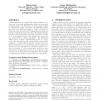Free Online Productivity Tools
i2Speak
i2Symbol
i2OCR
iTex2Img
iWeb2Print
iWeb2Shot
i2Type
iPdf2Split
iPdf2Merge
i2Bopomofo
i2Arabic
i2Style
i2Image
i2PDF
iLatex2Rtf
Sci2ools
118
click to vote
PODC
2006
ACM
2006
ACM
On the complexity of distributed graph coloring
Coloring the nodes of a graph with a small number of colors is one of the most fundamental problems in theoretical computer science. In this paper, we study graph coloring in a distributed setting. Processors of a distributed system are nodes of an undirected graph G. There is an edge between two nodes whenever the corresponding processors can directly communicate with each other. We assume that distributed coloring algorithms start with an initial m-coloring of G. In the paper, we prove new strong lower bounds for two special kinds of coloring algorithms. For algorithms which run for a single communication round—i.e., every node of the network can only send its initial color to all its neighbors—, we show that the number of colors of the computed coloring has to be at least Ω(∆2 / log2 ∆ + log log m). If such one-round algorithms are iteratively applied to reduce the number of colors step-by-step, we prove a time lower bound of Ω(∆/ log2 ∆ + log∗ m) to obtain an O(â...
Related Content
| Added | 14 Jun 2010 |
| Updated | 14 Jun 2010 |
| Type | Conference |
| Year | 2006 |
| Where | PODC |
| Authors | Fabian Kuhn, Roger Wattenhofer |
Comments (0)

